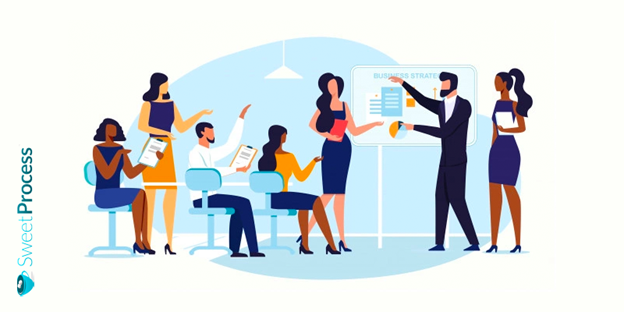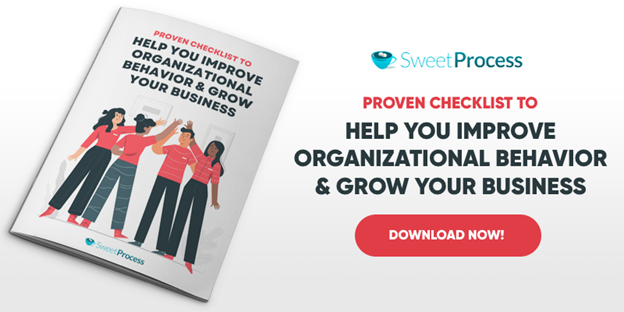Last Updated on February 6, 2025 by Owen McGab Enaohwo
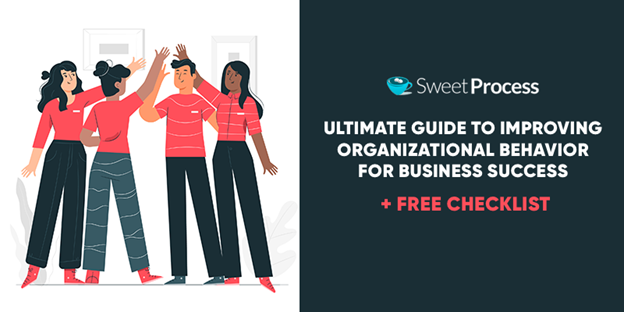
What is the ultimate ticket to business success? Is it having outstanding products or services? Cutting down your expenses? Knowing how to manage profit and loss? Scheduling tasks at the right time?
Well, even though quality products and services count, the actual key to your growth in any niche lies with the behavior of your employees.
The behavior of staff working in your organization is the most essential factor that determines your business success.
Working toward improving organizational behavior is so rewarding, whether in saving time, increasing productivity, or increasing profits. However, training, guiding, and influencing your team members to do the right thing at the right time can be physically and mentally exhausting.
So the question is, is it even possible to improve organizational behavior in your company? The answer is, yes!
It doesn’t matter if you’re in the healthcare, hospitality, rentals, coaching, or retail business. This article will suggest proven tips, strategies, methods, and practices to build strong, dedicated, and productive employees.
Organizational Behavior Guide – Chapter Index
Chapter 1: What is Organizational Behavior?
Chapter 2: Elements of Organizational Behavior
Chapter 3: What Influences Organizational Behavior?
Chapter 4: Why You Need to Improve Organizational Behavior in Your Company
Chapter 5: Approaches to Understanding Organizational Behavior
Chapter 6: The 5 Management Models on Organizational Behavior
Chapter 7: Best Tips to Improve Organizational Behavior in Your Company
Chapter 8: Examples of Companies With Good Organizational Behavior
Chapter 9: How SweetProcess Can Help Improve Organizational Behavior in Your Company
Before we show you how to apply these tips to improve organizational behavior, let’s look at what organizational behavior is, what influences it, why you need to improve it, and other key concepts around it.
Chapter 1: What is Organizational Behavior?

Definition of Organizational Behavior
Organizational behavior (OB) is the analysis of how people act and behave in organizational settings. It explains the dynamics that arise between individuals and groups in a workplace.
It doesn’t look into how groups operate together, but how an organization itself behaves, and how these relate to and influence each other.
That’s because the synergy between your employees will determine their efficiency, and so their compatibility is essential to avoid hiccups. Without this unity, it is impossible to achieve long-term business success.
The most successful business managers drive performance not only via enhancing worker productivity but also by improving workplace experience and job satisfaction.
This can be achieved by understanding what motivates employees, how they interact within themselves and with management. This is what organizational behavior is all about.
Understanding these elements and their dynamic interrelationships can help business leaders achieve short- and long-term goals for improving employee productivity and success by informing strategies around training, continuous improvement, cooperation, and workforce procedures.
History of Organizational Behavior
The need to quickly identify and remove unfit company policies to increase job satisfaction and boost employee performance, while increasing profits, is not a new strategy.
Starting from 1760, the industrial revolution led to the use of new technologies, production strategies, and increased mechanization.
These changes brought socio-cultural changes, including novel forms of organization.
These led Max Weber, a German scientist, to say that bureaucracy is needed in every organization based on rational-legal principles, charismatic leadership, and maximized technical efficiency.
In the 1890s, people studied organizational behavior as an academic discipline, with an emphasis on scientific management which was introduced by Frederick Winslow Taylor, an American mechanical engineer and theorist.
However, the ineffectiveness of scientific management led to the human relations movement. The system involves strategic goal setting, rewards (to motivate workers), cooperative teamwork, ethical behavior among staff, a positive work environment, and heavy emphasis on employee cooperation and morale.
These movements marked the beginning of the field of organizational behavior and made organizational behavior studies an academic discipline.
Chapter 2: Elements of Organizational Behavior

The study of organizational behavior can’t be finished without discussing the important elements. This is because it’s only when you understand how these elements relate to each other can business improvements be possible.
These elements include:
- People
- Structure
- Technology
- External environment
People
People make up for the workforce in any organization. They carry out the day-to-day activities needed to achieve business goals.
However, their skills, roles, goals, drive, and aspirations differ. As new employees come into your company, you need to train them on business procedures to prevent poor performance.
Aside from that, you need a good reward system to encourage competent staff to keep up. This is because, without incentives to motivate high performers, they may feel discouraged over time.
Expert knowledge of employee personalities will help to improve employer/employee relations, and productivity increases the more you understand this element.
Structure
The structure refers to the formal relationship between you and the employees in your organization, starting from the least ranked to the highest-level staff.
They should all be ranked structurally to enable them to work efficiently.
To get them to perform their duties as expected, their roles, obligations, responsibilities, and duties need to be clarified.
However, going over the same training repeatedly is overwhelming. It takes up so much productive time from your schedule.
You don’t want that. That’s why you need to document your processes to improve workers’ efficiency and avoid costly mistakes so you can minimize losses, increase profits, and have free time too.
Technology
Technology is an important aspect of organizational structure in the 21st century. It determines the working process, assembles resources, documents processes, and affects how workers collaborate.
Technology helps employees perform their tasks effectively. In its absence, it is difficult for employees to work efficiently. Technology makes work easier.
When you properly use the right technology, you have the opportunity to enjoy benefits like:
- Avoiding having to commute to work every day.
- Holding meetings online.
- Allowing your staff to work remotely.
- Reducing overhead costs such as office utilities.
- Assigning duties.
- Tracking the daily output of individual employees with ease.
Besides that, technology helps to shape organizational culture and behavior. It helps workers put their social backgrounds aside. The technology avoids cliques and group tension.
The External Environment
Companies would prefer to control every aspect of their processes. However, external factors influence employee behavior in their workplace too.
These factors could be political, economic, social, or technological. For example, perhaps one of your employees has a relationship problem at home, or is dealing with money problems. They can melt down emotionally, and their output will drop.
Likewise, an employee with a happy home will most likely feel pumped up to finish tasks in your company.
Environmental changes in society can also influence your organization, like the effect of the #MeToo movement aimed at eradicating sexual harassment. Several firms have forced high-level executives to resign after credible charges were leveled against them.
In the same vein, brands are also responding to gender pay inequality by assessing the salaries of male and female employees to make sure similar jobs receive fair compensation.
By understanding how these elements interact with one another, leaders and managers can make improvements. While some factors are more easily controlled by the organization—such as its structure or people hired—it still must be able to respond to external factors and changes in the economic environment.
What Are the 3 Levels of Organizational Behavior?
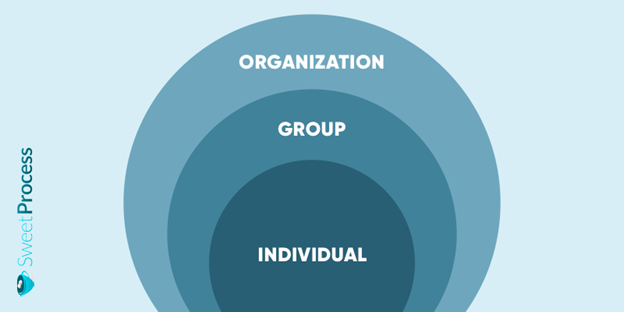
There are three levels of organizational behavior that shape employee attitude, culture, behavior, and perception. These levels comprise:
- The individual
- The group
- The organization
Individual Level
Your workers are like building blocks that make your organization.
Because they all differ in behavior, background, knowledge, and education, you need to understand them to leverage their abilities for business growth.
Understanding them involves analyzing their perception, personality, task performance, creative abilities, ethics, cooperation, desire for autonomy, motivation, and how these factors affect workplace productivity.
Group Level
We define a group as two or more who come together to interact and work toward a goal. Your goal is to figure out how their varying personalities relate to different leadership styles, and their outcome.
However, to get this right, you need to understand group dynamics and human interaction. These include studying leadership, politics, decision making, power, intergroup and intragroup cohesion, conflict resolution, interpersonal communication, and norms.
Organization Level
At this level, organizational behavior involves topics such as cultural diversity, inter-organizational cohesion and conflict, change and change management, external environmental forces, and organizational culture and structure.
Besides that, when groups are integrated, they make up (create) an organization. The focus you need at this level is to understand how people structure their working relationships as well as how your organization interacts with others in the marketplace.
Chapter 3: What Influences Organizational Behavior?

Certain conditions sway organizational behavior over time, and the environment influences these aspects.
Here are some factors that influence organizational behavior:
People
Knowing well that your organization comprises groups of people, and these groups can change, or disband, you need people with the knowledge to lead and manage your employees for increased cooperation and optimal results.
To make the best of your resources, you need the right people in these roles. To achieve this, you can use the following methods:
- Take time to carefully create a good employment procedure.
- Ensure that your HR department or recruiters follow it to the letter.
- Only employ staff who are not only qualified to work, but also have the right mindset that aligns with your company’s culture.
- Learn how to create a smooth and proper onboarding process so you can train new employees on your company’s procedures, mission, and policies.
This process can work. However, it can be mentally exhausting. To avoid going back and forth explaining repetitive procedures and tasks, simply use software like SweetProcess to automate it.
You don’t want your employees spending excessive time completing their tasks. Make sure your employees are adequately trained to perform their duties in fast and more efficient ways.
This way, you get to speed up their work process, reduce product defects, remove poor service, and increasingly maximize profits.
Environment
Companies don’t operate in a vacuum. They exist within the internal and external environment. They form part of an extended system that comprises the family, government, and other institutions. These elements (either internal or external) in the environment impact workers’ behavior.
For example, when top-level executives in your company are punctual and always beat deadlines, it nudges lower-level staff to be up and doing the same.
However, when top-level executives have a lazy attitude to work it tends to make the junior workers feel reluctant to go the extra mile.
Likewise, a business that operates in a highly regulated niche will have strict and organized behavior, and will conform to orders and regulations by the government and other regulatory institutions.
Structure
A company’s structure refers to the arrangement of staff into a hierarchy and the form of relationship between them. These relationships can influence employees’ behavior.
For example, some brands have strict structures that differentiate the relationship between managers and staff. As a result, their workers hardly join hands to execute projects. While in collaborative brands, both top-and entry-level staff are highly motivated to contribute, especially if they feel their opinions and input matter.
Tools
This not only has to do with manual machines and equipment but also the collaboration tools your team uses. Having access to the right tools can help you simplify your work processes and enable you to assign tasks to your staff, and even track their progress.
This positively affects employee behavior. In that, it helps them concentrate on completing tasks on time even though you’re not physically present to supervise their work.
Aside from that, having the right digital tools can help you automate things like documenting reporting structures, project and workflow management styles, processes, and employee onboarding.
Culture
We can see culture (chapter 15:3 or simply check the 3rd page of the slide) in an organization as a system of shared meaning held by members that distinguish the company from other brands.
Some of these systems of shared meaning include teamwork, shared vision, innovation, risk-taking tendencies, and outcome orientation.
Culture influences behavior in an organization based on the type adopted. For example, a company with a culture that promotes teamwork will enable employees to share ideas and will most likely crush its goals faster.
On the other hand, brands with cultures that cannot foster extroversion might experience poor cooperation, lack of shared ideas, and high employee turnover.
To enhance a positive organizational culture in your organization, you need to:
- Reward loyal and obedient staff more than you punish rule breakers.
- Give members the chance to suggest their ideas to have a sense of belonging.
- Allow employees to grow via fully-sponsored refresher courses.
- Lead by being excellent role models.
Chapter 4: Why You Need to Improve Organizational Behavior in Your Company
As your organization continues to grow and expand, people from different social backgrounds and orientations mix. Clash of opinions, personalities, and conflicts are bound to rise. As a manager, this calls for the need to refine your employee’s organizational behavior, to drive performance, service delivery, cross-team collaboration, and, of course, employee satisfaction.
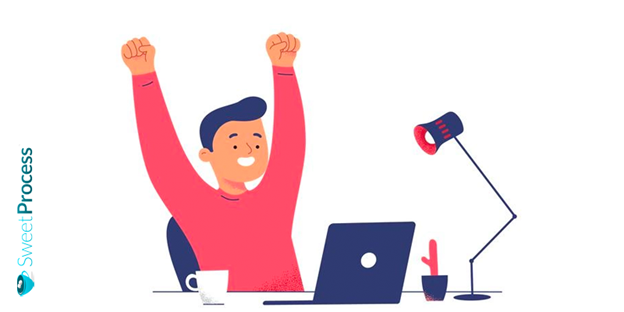
Here are some reasons you need to improve behavior in your organization:
Happy and Enjoyable Workplace
A key reason to analyze organizational behavior is to create a comfortable and cheerful workplace your employees will love.
A happy staff equals boosted employee satisfaction and increased performance.
An unhappy worker who is disappointed with an organization will feel discouraged and not give their best.
However, getting this right can be tricky. What’s right for one person might not be the same for the other. Some people feel burned out and irritated by certain policies, practices, and routines, while others may adapt to any condition easily.
As a manager, your goal is to take time and figure out what to adopt and what not, and that’s where the knowledge of organizational behavior comes in handy.
Influencing Management Style
Smart business managers use the knowledge of organizational behavior to guide them in creating a suitable company hierarchy and boss/employee relationship.
For example, constantly looking over the shoulders of employees implies a lack of trust, and leads to an uncomfortable workplace experience. By observing this tendency via organizational behavior research, many companies are switching to a model that allows workers to choose how they work and with whom over a hierarchical and strict structure that deprives them of such freedom.
Because it’s built on the recognition of employees’ personality differences, it gives them the voice to contribute ideas that affect their welfare and the organization. This also allows managers to build a strong connection that’s grounded in trust, effective communication, and transparency with their staff.
Creating a Winning People Strategy
Creating a workplace that motivates people to do more begins with building a winning people strategy. This is because employees want to work for brands with a positive culture and an embracing atmosphere. They also want to be supported by their co-workers and have a sense of belonging while they play their role in crushing your organizational goals and objectives.
However, the big problem is how to create an open, positive, and transparent work culture, one that enables staff to communicate openly, seamlessly collaborate with other employees, and multitask. (Youtube video 0- 24:55)
Creating a winning people strategy requires managers to define how they nurture their staff, build a positive work culture, and relate to them. This has a lot to do with building relationships, and a knowledge of organizational behavior helps to do just that.
Influencing Human Resource System
Business managers can enhance the value of their workforce by studying the complicated nature of their employees and their interactions with others.
The awareness and understanding that such a study provides can assist them in managing human resources and programs, particularly with new research studies showing a huge decrease in work-life balance because of an urgent need for staffers to work from home.
Managing personnel can spot struggling groups requiring moral support and give them adequate motivation suitable for their situation. They can help their staff become more productive by refining their workplace experience.
Fair Reward System
A renowned psychologist, Edward Thorndike once argued in his law of effect theory that:
“Responses that produce a satisfying effect in a particular situation become more likely to occur again in that situation, and responses that produce a discomforting effect become less likely to occur again in that situation.”
This simply means rewarded behavior gets repeated.
Now, how does that apply to you?
Your hardworking, innovative, and trustworthy staff need the incentive to keep up.
Nobody dislikes a nice reward after a job well done. Even the most low-key employee who doesn’t enjoy being praised by the public, due to, say, introversion or shyness, still likes that you’ve seen their efforts. Plus, it helps to build their self-esteem and motivates them to perform better.
Likewise, underperforming or difficult employees will be prevented from breaking codes of conduct to avoid losing their jobs. But how do you apply this principle without creating disunity, internal conflicts, factions, and unhealthy rivalry in your organization?
That’s why you need knowledge of organizational behavior—so you can correct bad employees and reward loyal ones the right way.
Conflict Resolution
Visionary managers go a step further to address issues before they strengthen into full-scale conflicts.
Assessing organizational behavior can help you as a business leader to quickly identify where your staff are having issues with coworkers or the leadership, so you can take preventive measures to resolve conflict and prevent a recurrence.
However, when you lack the right knowledge about organizational behavior, it might be hard to figure out what causes the crisis, and the right approach to address it.
Chapter 5: Approaches to Understanding Organizational Behavior

There are several approaches you can leverage to help your organization improve organizational behavior.
Every approach to studying organizational behavior aims to understand employee interactions in an organization, find what drives it, and influence it to increase productivity, customer satisfaction, and profits.
However, despite this common aim of influencing workers’ relationships to drive business growth, each of these methods applies to different business scenarios.
Some approaches focus on developing human or employee capacity. Others focus on how an adopted strategy determines productivity, and still others emphasize the premise that research or creating an inclusive system easily helps to crush company goals.
Here are the top four approaches to understanding organizational behavior for your business:
- Productivity approach
- Human resources approach
- Contingency approach
- System approach
Productivity Approach
Productivity is simply defined as the ratio of output to input; a measure of an organization’s efficacy. It also reveals the manager’s ability to optimize resource use. So, the higher the ratio is, the greater the productivity.
Back in the day, the concept of productivity was all about economic value alone. However, nowadays, besides the economic value, human and social inputs and outputs are so important.
For example, if positive organizational behavior can enhance job satisfaction and employee fulfillment, a human output occurs too.
Likewise, when employed personnel improvement programs lead to better citizens in the surrounding communities, a beneficial social output occurs.
Human Resources Approach
The human resources approach to understanding organizational behavior emphasizes the fact that people are the central element in any company, and that people need the training to improve their productivity.
It’s sometimes called the supportive approach. It differs from the traditional management method, where managers decide to set goals, and then strictly monitor them until they accomplish them.
In the human resource approach, managers switch from the usual controlling role to being supportive partners in performing tasks. Here, employees feel fulfilled in their jobs.
This is because they have the chance to bring creativity into the work process rather than being rigidly micro-managed by managers.
Contingency Approach
The contingency approach, unlike others, is more research-driven.
It discourages making assumptions about people’s abilities and the reliability of methods. Rather, it promotes the need to test and confirm whether a strategy can truly help an organization achieve its goals.
This method is also called the situational approach because it’s adopted based on certain situations. A strategy that works in one situation may not work in another.
As a manager, one needs to research and figure out a befitting method that aligns with your company culture so you can effortlessly exceed your business goals.
The reason this approach works is that it involves analyzing situations before taking action while discouraging assigning roles to employees based on assumptions, or even adopting a method of finding out if it’s worth it.
The Systems Approach
The systems approach sees the organization as a united system made of complementary aspects. In this approach, managers see the organization as an entire group and an inclusive social system.
The systems approach assumes that the activity of any area of an organization affects, to a large extent, the activity of every other part, and that every employee should see things that way.
For example, the secretary, the receptionist, and the director’s work impact the behavior of other employees, and their productivity too.
Managers, however, have a bigger task because they are the ones who set the pace for others to follow. For example, managers help to:
- Build a suitable organizational culture that grooms talents toward improved productivity.
- Create seamless business processes that increase productivity and achieve company goals.
- Benefit society through enhanced service delivery and quality products that satisfy their needs.
Chapter 6: The 5 Management Models on Organizational Behavior
We all have this innate ability to generalize and predict other people’s future behavior. However, our predictions are sometimes not accurate.
That’s because we hardly ever go in-depth to study the patterns influencing their behavior. This calls for an understanding of behavior models. The knowledge helps us to enhance our ability to foretell the behavior of employees in a workplace, how it affects their performance, and how to influence it for a company’s optimal performance.
Here are the five management models to help you apply the knowledge of organizational behavior:
- Autocratic
- Custodial
- Support
- Collegial
- System
Autocratic Model
The autocratic model of influencing organizational behavior was popular during the 18th and 19th centuries, especially during the industrial revolution.
It operates on a “do this now or else” principle. As Newstrom put it, the psychological result of the employees is reliance on their boss, whose power to “hire, fire and perspire” is unquestionable.
This model involves giving orders to employees who are expected to abide by them without hesitation. There’s little to no room for features such as:
- Creativity
- Flexible work hours
- Personal initiative
The autocratic model relies on strict instructions, punishments, and threats. It instills fear in employees and gets them to improve performance.
In this type of management model, even though some workers perform excellently, most employees are low-skilled. They don’t have as much mastery, aptitude, and capacity to perform tasks as expected since their managers do all the thinking. So, they largely rely on directives from their bosses.
Managers often embrace the autocratic model during crisis periods, which calls for drastic intervention, and in situations where employees are not top performers. It’s used to ensure they get up and do it.
Although, as workplace values are developing, the model is giving place to the modernized versions. We can’t say they have disposed of this model. In many business setups, it’s still proving to be an effective way to get things done.
However, with an increase in knowledge about organizational behavior and societal values, better ways to manage behavior in organizations are emerging.
Custodial Model
The custodial model was built on the premise that when an organization provides social security, incentives, and shows compassion toward its employees, it will boost their loyalty.
Managers used the custodial model around 1890 to 1900, after employers realized the failure of the autocratic model, to ensure employee satisfaction, and curtail their resentful and aggressive behavior toward high-handed managers.
As a result, managers launched social welfare programs to provide employees with incentives such as:
- High salary.
- Remunerations in the aspect of corporate cars, and health-care benefits.
- Reduced overtime work (extra work hours).
- Early retirement benefits.
- Favorable job transfers and relocations.
Later in the 1930s, more companies embraced these welfare programs to motivate their staff, which developed into what is now known as the custodial model of organizational behavior.
Supportive Model
The management in the supportive model is tasked with the responsibility of encouraging and motivating their staff.
Contrary to the autocratic model, the supportive model assumes that employees are normally self-motivated and can create value. The leader’s job is to boost their performance by supporting their interests, talents, and goals.
They do this with the assumption that employees will take initiative and improve performance on their own when given adequate support.
The desire to collaborate with team members to perform excellently drives the employees under this system. The worker prerequisite that is met is status and recognition.
Business managers also built a supportive model around striving for leadership positions. In that, it gives room for staff to grow and strive for leadership. It gives a climate to help employees grow and complete tasks while contributing to meeting the organization’s interests. The manager’s key role is to support them to achieve just that.
But how do they make that possible?
Well, they do this by simply creating a positive work atmosphere where employees give in to their ideas without fear or restraint.
Elton Mayo and Fritz Roethlisberger at the Hawthorne Plant of the Western Electric Company conducted a study in the 1920s and 1930s to study human behavior at work by paying keen interest into the sociological and psycho-social perspective in the business setup.
The researchers concluded that a company is like a social system, and a worker is an important part of the system. They found employees are not tools but humans who will have behaviors, needs, and feelings that need to be understood.
They suggested that understanding group dynamics, including supportive leadership and letting employees partake in decision-making, is essential to make workers play their roles and contribute toward achieving organizational goals.
Collegial Model
The collegial model is similar to the supportive model. It involves a lot of teamwork and collaboration between employees. It’s built on the premise that when workers share ideas and work together, organizational goals easily get crushed.
In addition, the hierarchy in this model is flattened. Managers don’t enforce rules and directives on the employees. No one is bossing employees; they all work together as a team to achieve set goals.
And just like a sports coach, business leaders only guide employees to give optimal performance instead of focusing on their personal growth. Workers under this model feel more comfortable working as there is little or no fear of being laid off.
However, collaborating with teammates across borders is hard. Even collaborating within walking distance is stressful.
For example, when a manager wants to introduce a new procedure, or perhaps new employees want to learn about company processes, their productive time might be wasted reiterating routines repeatedly.
This calls for research to find strategies and smart technology that enhance team collaborations, reduce endless back-and-forth emails, and virtual meetings talking over the same processes when you could just document and automate the walkthroughs.
System Model
The system model is a newer organizational behavior model built on the need to increase passion and dedication to the organization’s goals. This model is about giving workers a high level of meaning at work which leads to more fulfillment and higher performance.
The model requires managers to show tolerance and care toward their worker’s welfare and to create a beneficial workplace culture. It also gives employees a sense of belonging to a family.
So, how can this be achieved?
You can do this by creating a workplace culture that is positive, ethical, respectful, and blended with trust and integrity. It gives room to develop a communal feeling among the co-workers.
In addition, you may need to devote time to creating a feeling of optimism, transparency, trustworthiness, courage, and self-determination. This ultimately enhances employee loyalty and the success of your company.
While managers try to enhance collaboration, transparency, and social intelligence, employees have a sense of belonging to the grand plan of the organization. Their efficiency and output increase because they’re no longer driven by personal goals but by how they can help their company exceed all expectations.
All these models emerged as employee needs increased. Each type served as a stepping stone for more effective models.
And to say that any of the management models are the best is wrong. As none of them are perfect, but gradually transformed as our perception, experience, and social factors affecting behavior changed.
You can pick any of the behavior models and change them, and apply them in unique business situations.
Chapter 7: Best Tips to Improve Organizational Behavior in Your Company
Improving performance and commitment in your workplace is a common problem managers and HR professionals face, especially nowadays when continuous organizational change has become constant.
Although we’ve talked about the models you can adopt, blend, or tweak to improve behavior and crush organizational goals, let’s now look at some of the best tips you can leverage to improve organizational behavior and employee compliance in your company:
- Show empathy.
- Create a reward system.
- Empower and train employees.
- Properly communicate company values.
- Have an effective employee selection system.
- Show flexibility and encourage productivity.
- Support personal development and learning.
- Leverage technology.
Show Empathy
Aside from hiring, one more difficult problem you’ll face in your career is knowing exactly how your employees need you to adjust; hence, the need to identify and address their problems. When you avoid addressing workplace problems you can squash their motivation and commitment to work.
Don’t be an insensitive manager who doesn’t care about workers’ comfort in their workstations. It’s why you need to survey your employees to learn how they feel about their workplace. Merely making assumptions might not help you make proper adjustments.
Research has shown that employees who are treated as people with different interests, likes, dislikes, and aspirations perform better than those who are not.
In this new era of human resource management, more employees find fulfillment in a comfortable workstation than in making more money in unconducive environments.
Create a Reward System
Nobody likes to work without an attached gain or benefit. People feel charged to do more when there’s a reward they hope to gain.
So how can you leverage this to your company’s advantage?
You do this by rewarding loyal, compliant, and hardworking staff for achieving a milestone, or by making sure they have a picture of “what it’s in it for them” from the get-go. This encourages them to put in more effort into completing tasks, and behave well so they can qualify for the reward.
Empower and Train Employees
As new staff come into your organization, they know a little about your company from what they saw on your job ad, or perhaps just the little they learned as they glanced at your company website.
So, as a manager, you need to ensure these new staff learn and understand their duties, roles, and responsibilities to avoid making costly mistakes.
Apart from that, more experienced workers need refresher courses and tutoring about new machines, policies, work methods, and processes to speed up their work.
Another important area to focus on when trying to improve how your business runs is to lead based on the “motivate but don’t dictate” principle, especially when assigning tasks to your employees.
How?
By asking questions that inspire and lead them to the right solution. Ensure you explain the reasons behind changes in company policies.
These methods help to motivate workers as they feel like they are part of a great team moving toward a target rather than feeling like a cog in a wheel.
Properly Communicate Company Values
Properly communicating company values is the most important element of these. An employee who doesn’t understand your company values will find it hard to fit into your organizational culture.
Also, making avoidable mistakes while explaining company procedures, individual tasks, and processes often leads to poor performance, poor quality goods, or service delivery.
To avoid this, you need to have a well-scripted step-by-step walkthrough of every single repetitive task.
Why?
Doing this will easily assist confused employees on how to go about a particular procedure or task without second-guessing, wasting time, or even bugging you with questions now and then.
And, as you communicate, keep track of your words and ensure your statements are self-explanatory. A clear and concise message will keep the focus on the main goals and prevent mishaps, late completion of tasks, and constant excuses.
Have a Proper Employee Selection System
Studies have shown that human resource personnel are excellent at coming up with smart business strategies and helping improve company performance.
It’s why knowledge of human response management is important. Aside from that, you can also get human resource professionals involved in the design of transformational changes within your company.
They may offer unique opinions and ideas that leaders may forget and play a key role in identifying the right experts to fill new roles within a company.
Having a proper employee selection system helps you easily achieve business objectives. Recruiting employees who suit the organization’s culture helps to maintain behavioral standards. Any form of mismatches can lead to serial conflicts and behavioral problems. As a result, it can hurt people’s readiness to adjust.
In addition, ensure that your job listing clearly describes the type of employee you’re looking for. But above everything else, hire applicants based on their work ethic and honesty—nearly all other skills and abilities can be learned.
Flexibility and Productivity
Maintain accountability. During any business process, including change projects, accountability is a must. Someone should delegate duties properly and project coordinators should implement mechanisms that ensure they carry those duties out.
Another important aspect, besides hiring the right employees and training them on company procedures, is to achieve set objectives. Managers are to ensure that employees’ level of performance is beyond par. The smart way to achieve that is by tracking key metrics which motivate employees to perform better while keeping them accountable.
Choosing the metrics to assess is important in ensuring high productivity by workers. Asking questions like the ones below can help you.
- What are the major goals my teammates are working to achieve?
- Are the goals clearly defined and spelled out by team leaders?
- How and by what extent will improvement be measured?
As a business leader, your job is to create and maintain the measurement system to track improvement and review its status regularly.
To improve organizational behavior, it’s important to realize that holding employees accountable to their goals helps to keep them moving forward.
An organization should have effective accountability systems and structures in place to maintain clear objectives throughout the organizational setup.
To achieve this, you need to implement the following steps:
Define Goals
Clearly defined goals make it easy for employees and managers to know when there’s improvement or failure. For instance, you can use the SMART system to set clearly defined goals in your company. These goals must be specific, measurable, actionable, realistic, and time-bound
Taking this first step and drafting a plan of action and working toward crushing them is just one piece of the puzzle to improving organizational behavior.
Defining goals—and creating an action plan to work toward them—is only one step on the path to changing organizational behavior.
Clearly Define Rules & Expectations
In the same way that your goals need to be clear and straightforward, so do your expectations about team performance.
Getting this right and ensuring it is straightforward and that it applies to both leaders and employees will help to keep everyone in check. PIus, it ensures they maintain high working standards. However, if you currently observe that these expectations are not being met, it’s high time you made adjustments.
Development and Learning
As a business leader, you need to identify areas where different experts have strengths or weaknesses even before you draft a plan to improve your organization’s efficiency.
After spotting their strengths and shortcomings and their diverse educational backgrounds, simply focus on growing your company by building effective teams.
How?
You can do this by developing teams with complementary skills and strengths. Then encourage them to set specific goals and assign them to do assignments based on their experience and educational background.
Leverage technology
Aside from using computers to improve efficiency, you need to find SaaS tools that enhance business efficiency. For instance, find one that enables you to effortlessly train, assign, and manage tasks, and stay organized.
Leveraging technology helps you enhance organizational behavior in the following ways:
- Upskilling your employees to work efficiently in your absence.
- Ensuring seamless collaboration on projects.
- Documenting your processes and procedures helps to eliminate errors and misinterpretations.
Chapter 8: Examples of Companies With Good Organizational Behavior
There are a lot of companies that have done well in terms of improving organizational behavior. What follows are some of their key strategies, techniques, and structures. Examples of these companies are:
- Toyota
- Ford
- Apple
Toyota
Even in the U.S. alone, Toyota Motors is competing with General Motors for market share leadership. It is also the major provider of hybrid vehicles.
One of the key factors responsible for its success in the automotive industry is a constant desire to improve organizational behavior.
Teamwork
Teamwork is a fundamental aspect that has led to Toyota’s improved employee behavior and all-around growth.
They even make it compulsory for every employee to get trained in team building. That’s because Toyota is built around the saying that:
“Teamwork makes the dream work.”
Their managers expect every worker to join hands with others to execute tasks.
Continuous Improvement
Toyota believes that only qualified staff can give their best, and only then can they satisfy their customers and make enough to compensate their employees.
It’s why they always emphasize continuous improvement through constant staff training.
Employees’ Growth & Satisfaction
Over the years, Toyota has proven itself to be one of the top automobile manufacturers to work for in North America.
To them, their greatest resource is flexible and motivated members. Hence, respect for employees is equally important to them as total quality management (TQM).
In the company, managers and directors are mainly there to support members’ growth. That’s because one of their guiding principles is:
“We build people before we build cars.”
And unlike in most organizational settings where top-level executives boss around and expect people to follow strict orders, Toyota’s style is unique. Their managers are always there to ask how they can be of help to employees. That alone makes their employees feel appreciated and boosts their productivity.
Ford
Ford has, over the years, become a leading player in the automobile industry. However, it didn’t just grow overnight into a force to reckon with by mere chance. Its leaders have adopted some strategies and policies which help to improve the organizational behavior in the company.
Leadership Structure
Ford has a highly hierarchical structure. These structures are strict, and not to be broken. They set a pace for their staff to follow. The leadership structure is based on the working together management system, or WTMS for short.
The leader behind Ford’s progress is Alan Mulally, former CEO of Boeing Commercial Airplanes, who assumed office as CEO of Ford after it nearly went bankrupt.
Mulally transformed the company into a profitable corporation by building an engaging workforce with his One Ford plan.
Under this plan, Ford had a large number of employees who rely on, respect, and care for each other. They build networks and partnerships without barriers. The WTMS system encourages everyone to openly communicate and contribute their unique ideas, and work together as ONE big family.
Consistent Customer Satisfaction
A focus on consistent customer satisfaction has been one of Ford’s biggest strategies to keep customers, make sales, and make enough money to reward their staff.
Since Ford knows their customers love posh cars, they gear their research toward making cars that satisfy their customers’ thirst for sleek cars.
They achieve this by inviting their loyal customers to lunch for a brainstorming session to discuss what they expect or feel their market wants so they can blend those desires with their next product line.
Employee Satisfaction
Employee fulfillment is important. Any business manager who takes it lightly might lead their business to fail.
For instance, during the time Ford merged with Volvo, they involved their workers in the decision-making process to make them have a sense of belonging. As a result, it boosted employee participation and contribution to the company’s growth later on.
Research has shown that they made decisions at the lower level unlike in some firms, where every decision is done at the upper level.
Years after the merger, the company introduced a program that allows its workers to upskill without it interfering with their normal work time.
Apple
Apple is a popular company worldwide. It deals with the design, manufacture, and sales of mobile devices, computers, and movable digital music players.
As of 2020, they rated the brand as the first company to hit a $2 trillion market cap. Now let’s talk a look at some of the organizational behaviors that helped them scale their company:
Leadership
Leadership is an important element in building any business. It’s a function that directs and guides people’s behavior in an organization.
Although it often looks like a simple task, it requires a high level of performance and commitment to get it right.
After Steve Jobs died, Tim Cook took over and continued where his predecessor left. Cook has a democratic leadership style that enables everyone to use their talents to contribute to Apple’s success.
However, it doesn’t mean that he lets other executives make decisions on his behalf. Rather, he keeps an open mind, evaluates his options, and encourages other staff to follow his lead.
Teamwork
The most crucial aspect of any successful company is teamwork, and Apple seems to get it right. It doesn’t just help to foster collaboration and idea-sharing; it helps to speed up the execution process through proper division of labor.
The Apple CEO once said:
“Teamwork depends on trusting the other folks to come through with their part without watching them all the time.”
With the increase in loyal customer base and high expectations, Steve Jobs had to ensure that teamwork was instilled in their organizational behavior.
He achieved this vision by:
- Making sure they met once a week.
- Allowing members to bring suggestions and argue their points to bring out their potential.
- Making sure project teams were always working toward one goal.
Stress Management
Observing certain stress-reducing activities can help to combat anxiety, reduce mental and physical stress, and fatigue, increasing productivity.
But how do Apple employees stay sane despite the need to come up with creative ideas, beat deadlines, and meet a constant desire for smarter and sleeker phones from their customers?
Steve Jobs believed that if he allowed his staff to observe 30 minutes of meditation daily it would make their workplace more enjoyable.
He practiced meditation consistently and even provided classes on meditation and yoga. He believed if they gave employees more time to destress daily, their mental health would be enhanced. This key factor helps their staff reduce burnout and increase productivity.
Goal Setting & Motivation
Many people still believe that Apple’s goal is to make a profit. However, Apple’s number one goal is to delight its customers. They believe that by thrilling their customers, their consumers will feel encouraged to buy more, and it’ll boost their bottom line. It’s a win-win situation.
But then, researching to get the right info about customers’ wants and working toward satisfying them can be exhausting. Apple encourages its employees to work together on projects.
The company believes in empowering its workers to not only believe in the brand but themselves. Steve Jobs promoted what’s called socialized power. That is when someone uses their power to take an interest in others and the goals of the company, thus helping to connect and motivate every team member.
Negotiation
Negotiation is a dialogue aimed at reaching a mutually beneficial agreement.
Negotiations are necessary for any company that seeks to grow itself. And with Apple, Steve Jobs was a master negotiator. He knew how to persuade his employees and team members to get the job done. Plus, he’s widely known for leveraging emotions to get people to say yes to his offers.
Chapter 9: How SweetProcess Can Help Improve Organizational Behavior in Your Company
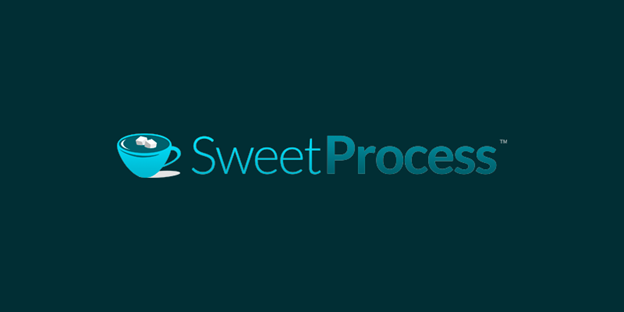
Deciding on an app to help you train new and experienced employees to enhance their efficiency can be so confusing.
Many apps help users meet their organizational goals. However, you don’t want to stuff your device with too many apps. That will cause distraction and slow down your work process.
If you’re looking for reliable software to help you train, guide, and improve employee behavior in your company while enjoying a work-life balance, then SweetProcess is the right software for you.
Aside from helping you easily perform tasks, it serves as a reliable collaboration tool for effective teamwork.
It goes a step further by helping you easily grow and scale your business without unnecessary burnout.
For example, see how SweetProcess helped Optiable improve employee performance and increase productivity. Before they began using SweetProcess, the team, led by Craig Bayer, the CEO of Optiable, had a hard time manually documenting their current processes. Aside from that, he was micromanaging his staff which took a chunk of his time at the expense of other important tasks.
Craig and his staff couldn’t perform the simple tasks and be assured that all was well. There was always a chance that something was wrong somewhere. No matter how careful they were, they just couldn’t trust each other’s performance.
In his words:
“We always would be triple checking our work.”
Manually cross-checking hundreds of items on their to-do list was tiring and slowed down productivity. But since they began using SweetProcess, things have changed.
SweetProcess helped them document detailed business processes which improved their employee behavior and efficiency. They were able to turn what was overwhelmingly hard into an organized workflow by automating recurring tasks.
Likewise, Jamie Ramsden, business intelligence and lean Six Sigma champion at Turkstra Lumber, wanted to scale their business but they weren’t as organized as they should be. They executed tasks differently, leading to inconsistency in the company.
“One of the things that prevent you from being correct and doing things better than you do now is when you don’t know what your processes are or if everybody isn’t on the same page,” he said.
Determined to properly document their processes, Jamie and his team started to learn about the lean concept, and began to document their processes in Excel Sheets, but the results were far from what they needed.
“Not that there’s anything wrong with Excel or homemade-looking things, but part of it is that there’s no coordination there. You’re trying to pass things around. The people who you need to participate often don’t have good access to the materials you’re trying to trade back and forth with them, and they certainly aren’t that interested in participating that way, so you’ll end up with a top-down approach that is ineffective at best.”
Tired of the back and forth with using the Excel Sheets, they chose to get something better to help them rein in all those procedures that they thought they understood but felt weren’t coordinated.
Then they discovered SweetProcess. With SweetProcess, they could easily onboard and train employees on company procedures and processes, and scaling became less stressful.
SweetProcess gives you a lot of options to save time, stay productive, and build an efficient team that delivers in the following ways:
- Document your procedures step by step.
- Organize several processes to form a workflow.
- Use procedures to assign roles to team members.
- Collaborate in real-time with co-workers and share ideas for improvement, where necessary.
- Create a knowledge base so your team members can easily access anywhere from your procedures and policies.
- Integrate with over 1000+ software and apps.
- Track corrections made to tasks with the history of each correction.
- Easily embed files like audio, pictures, and videos to your tasks.
- Secure your account with two-factor authentication so you don’t get hacked.
- Get instant support anytime you need help via email.
- Edit screenshots and images with just a few clicks—right inside the app.
- Restrict access to selected members of your choice.
- Print your documents for offline use.
- Plus, there are truly NO hidden costs. You only pay for the months you’re using it.
And of course, it comes with a 14-day free trial. No credit card is required to try it out.
When you sign up, you get to benefit from these and more with SweetProcess. But don’t take our word for it. Try it yourself and decide if it’s right for you. With our 14-day free trial you can enjoy the features.
Click here to sign for a free 14-day trial and start working smarter and not harder so you can focus on what’s important to you.
Conclusion
We’ve given you all the important information you need to improve employee behavior within your company.
However, if you don’t want to be overwhelmed by going through this article to pick out lessons to use, we made it easier for you.
How?
We’ve created a short checklist of what to do so you can improve organizational behavior in your company. To get your copy of the checklist, simply click on the link below:

